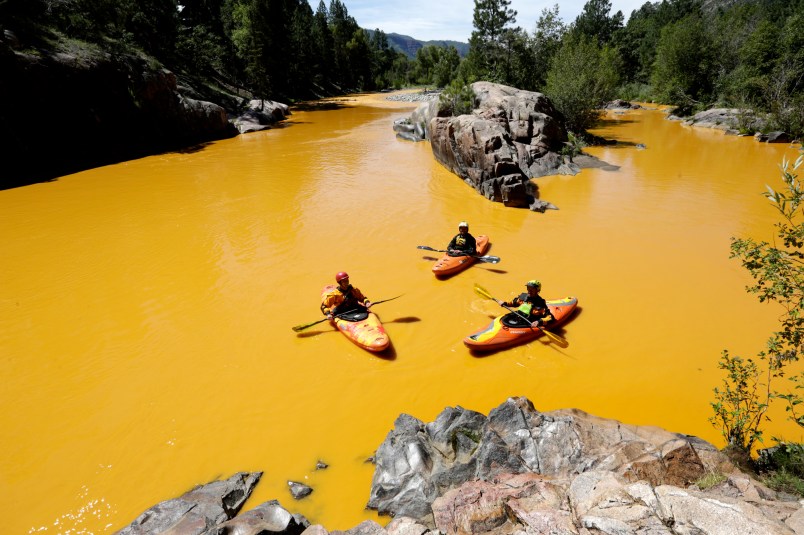DENVER (AP) — Tribal officials with the Navajo Nation declared an emergency as a massive plume of contaminated wastewater from an abandoned Colorado mine flowed down the San Juan River on Monday toward Lake Powell in Utah, which supplies much of the water to the Southwest.
Some drinking water systems on the Navajo Nation, which spans parts of New Mexico, Arizona and Utah, have shut down their intake systems and stopped diverting water from the river.
Drinking water is being hauled to some communities.
Navajo President Russell Begaye said the tribe is frustrated with U.S. Environmental Protection Agency and he plans to take legal action. An EPA-supervised crew has been blamed for causing the spill while attempting to clean up the mine area.
Elsewhere, farms along the Animas and San Juan river valleys in northwestern New Mexico have no water to irrigate their crops after the spill.

A woman holds a bottle of water collected form the Animas River north of Durango Colo. (Jerry McBride/Durango Herald via AP)
The yellow plume of wastewater stretches 100 miles and was three times larger than initially estimated, federal officials say. The EPA initially estimated 1 million gallons escaped.
The water is laced with heavy metals, including lead and arsenic, and spilled from the Gold King Mine in the historic town of Silverton, turning the Animas River in Colorado a mustard yellow last week.
The spill reached the New Mexico municipalities of Aztec, Farmington and Kirtland over the weekend.
The EPA has so far been unable to determine whether humans or aquatic life face health risks from the pollution.

Dan Bender, with the La Plata County Sheriff’s Office, takes a water sample from the Animas River near Durango, Colo. (Jerry McBride/The Durango Herald via AP)
The Navajo Nation in its declaration stated the toxic spill will have long-lasting and unknown impacts on the tribe’s water system and wells.
No drinking-water contamination has been reported because water utilities shut down their intake valves ahead of the plume to keep it out of their systems. Farmers also closed the gates on their irrigation ditches to protect their crops.
Colorado authorities said Monday there were no reports yet of harm to wildlife in that state.
The state’s Parks and Wildlife agency said it had inserted cages with more than 100 fingerling trout into the river in southwest Colorado near Durango.
The fish are sensitive to changes in water quality. As of Monday, only one fish had died, but the agency said it didn’t know if that was because of the metals in the water.
The sludge moved so quickly that it would not have caused significant health effects to animals that consumed the water, EPA toxicologist Deborah McKean said.

Ducks wade in the Animas River as orange sludge from a mine spill upstream flows past Berg Park in Farmington, N.M. (Alexa Rogals/The Daily Times via AP)
The leading edge of the plume was headed toward Utah and Montezuma Creek near the town of Bluff, a tourist destination. The town, which is populated by a few hundred people, is surrounded by scenic sandstone bluffs.
Local officials prepared to shut down two wells near Montezuma Creek, said Rex Kontz, deputy general manager for the Navajo Tribal Utility Authority.
To keep water flowing to homes, the residential tank in Halchita has been filled with clean water that was hauled 40 miles from Arizona.
In Colorado, the EPA planned to meet with residents of Durango, downstream from the mine as water tests from near the city were being analyzed.
Federal officials have not said how long cleanup efforts will take.
The mine has been inactive since 1923.
A family farm that serves as many as 3,000 customers in the Four Corners region has been forced to stop irrigating dozens of acres.
D’rese Sutherland of Sutherland Farmers in Cedar Hill, New Mexico, said she received advanced warning from farmer friends in Colorado about the approaching plume.
Trucking companies that work with the region’s oil and gas industry have offered to haul water to the farm, but Sutherland said it would require a significant amount to keep the chile, pumpkins and other vegetables watered.
There was no indication of when the water will be safe to use again, she said.
Members of New Mexico’s congressional delegation sent a letter to EPA Administrator Gina McCarthy, expressing concern over the failure of the agency to notify New Mexico sooner.
They also asked that the agency develop a plan for dealing with the lack of water for communities in San Juan County and the Navajo Nation.
“We have yet to be presented with a comprehensive plan from the agency to provide water to those whose wells have been affected, farmers whose crops are not being irrigated, ranchers whose livestock are without water, and people for drinking, cooking, and showering,” the letter stated.
___
Associated Press writers Lindsay Whitehurst in Salt Lake City and Susan Montoya in Albuquerque, New Mexico, contributed to this story.
Copyright 2015 The Associated Press. All rights reserved. This material may not be published, broadcast, rewritten or redistributed.







An entire river of orange juice?! Oh wait, just another toxic spill. Move along, everybody, nothing to see here!
We are talking about heavy metals that have long since been known about. It’s my understanding that the reason the EPA was there in the first place is that there may have been discussions as to declaring the old mine a Superfund site which apparently was being fought by the locals. No more fight, now.
JarJarBush and his Band Of Thugs , have been methodically weakening the EPA…
ThankeeJe$u$!
They could bottle it, and call it Tang.
…from her moon suit, behind a containment wall, before hastily abandoning the press conference.